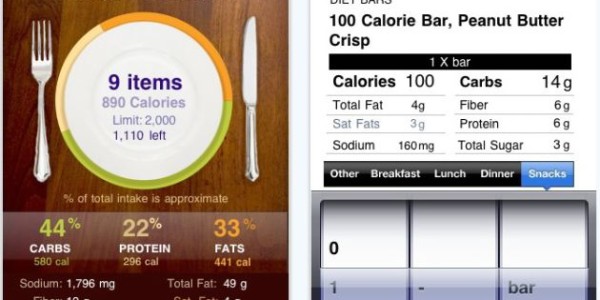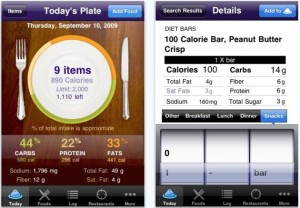One “diet” method that will stand the test of time is calorie counting. If you’re goal is weight loss or fat loss, the amount of calories you eat each day will have the biggest outcome on your progress.
With today’s technology, there are countless apps you can use to log your foods. They usually provide you with a total of all your calories and macronutrient ratios.
These are great because they provide a sense of how many calories are actually in the foods you eat. There will always be a debate whether or not these are 100% accurate but it doesn’t really matter. It’s close enough.
While many have enjoyed success with counting calories, others find it to be a chore. And it very well could be. Having to constantly log your food takes time. Time that some people don’t want to give up.
And that’s the problem.
To lose weight or body fat, you need to take in less calories than you expend on a daily basis. In order to do this accurately, you need to know how many calories you’re eating. If you’re unwilling to track your calories, you obviously won’t know.
But that doesn’t mean you’re doomed to never see results. There’s actually an easier way to count calories. And the good news is, it doesn’t involve any calculators or phone applications.
Before we get into that, you need to determine how many calories you need to lose weight. To do that, there’s a simple equation I like to use.
Bodyweight x 10-12 = calories/day
This is simple and can be individualized quickly. If you are more active during the day (i.e. you train 3-4 per week or have an active job) than you can stay on the high end of the equation. So if you weigh 175 lbs the equation may look like this:
175 x 12 = 2100 calories/day
On the other hand, if you train 1-2 times per week or have a job that requires you to sit more then you can hang around on the lower side of the equation. So the equation for the same 175 lb. person would look like this:
175 x 10 = 1750 calories/day
Now, you may find that you aren’t seeing any progress by following these calorie guidelines. That’s ok. Every person is different, and you’ll need to do a simple adjustment. For example, if you multiplied by 12 and are maintaining your weight, then try multiplying by 11.
If you have a lot of weight to lose (100+ lbs.), you can also lower this number. Multiplying by 7 or 8 would provide you with a more accurate and manageable calorie count.
Now that you know you’re caloric intake, you can start counting calories. The 3 main macronutrients in foods are protein, fat, and carbohydrates. The calories per gram of each nutrient are as follows:
- 1 gram of protein = 4 calories
- 1 gram of fat = 9 calories
- 1 gram of carbohydrate = 4 calories
To use this simple method of counting you only one thing, your hand. You will be comparing food to the size of your hand and using that to determine the amount of calories. Let’s look at the three nutrients.
Protein
Protein is arguably the most important nutrient for fat loss. It keeps you fuller for longer, helps build lean muscle, and aids in recovery. Strive to get .8 – 1 gram per pound of bodyweight each day. For our 175lb. person this would be 140-175 grams/day.
Here’s some protein examples and how you would count it:
1 palm sized serving of meat
- 4 oz
- 25g of protein
- 120-200 calories depending on leanness of meat
1 closed fist sized serving of greek yogurt
- 8 oz
- 20g of protein
- 120 calories
1 closed fist sized serving of cottage cheese
- 8 oz
- 25-30g of protein
- 160-200 calories depending on brand
Fat
Fat has been demonized for making people fat, but it’s actually quite the opposite. Good fats like olive oil, fish oil, and nuts can provide satiety and decrease inflammation making fat loss easier. With each meal, try to get a minimum of 15-20 grams. For our 175lb. person this would be 45-60 grams/day. This could be more if you like higher fat foods versus carbs.
Here’s some fat examples and how you would count it:
1 thumb size portion of coconut or olive oil
- 1 tablespoon
- 14g of fat
- 120 calories
2 thumb size portions of nuts
- 1/4 cup
- 13-20g of fat
- 160-200 calories depending on the type
** There is also fat in meat, so be aware of this when eating your protein.**
Carbohydrates
Like fat, there’s a big misconception that carbohydrates are responsible for making people gain weight. But again that’s not entirely true. Carbohydrates are in most processed foods now.
So it’s not carbohydrates that are making people heavier, it’s the overconsumption of them. If you over-consume anything you will gain weight.
Carbohydrates from the good sources like fruits, vegetables, and sweet potatoes can improve heart health, are filling, and provide much needed energy so we can train harder. Focus on filling in the rest of the remaining calories with carbohydrates. For our 175lb. person this would be 130 grams of carbs if eating 1 gram of protein per pound of bodyweight, 20 grams of fat each meal and 1750 calories per day.
Here’s some carbohydrate examples and how you would count it:
1 piece of whole fruit like an apple or 1 fist sized portion of berries
- 8 oz
- 25g of carbs
- 100 calories
1 medium sized potato or sweet potato
- 8 oz
- 25g of carbs
- 110 calories
1 closed fist sized portion of rice
- 8 oz
- 45g of carbs
- 200 calories
Don’t worry about counting vegetables. They are so little in calories that it won’t make a big dent in your overall calorie count. Aim for 1-2 fist sized portions with each meal.
Enjoying treats
We will always be surrounded by treat type foods. Whether it’s alcohol, tortilla chips at your local Mexican restaurant, or my personal favorite: chocolate, you need to be aware of this. I want to briefly mention how you can also enjoy treats without having to count calories.
You can and should enjoy treats from time to time. Not indulging every now and then, could lead to a binge down the road, which isn’t good for anyone. But you need to be smart about it.
Mindlessly eating treats everyday will make it hard to find success. You need a system in place that allows you to enjoy them without overindulging.
Here are my two favorite strategies to enjoying treats without it hindering your progress or caloric intake.
1. Decrease your carbohydrate intake during the day
By dropping your carbs during the day, you save room for your treat. For example, if I’m taking my wife out to dinner and know that we will have dessert, I won’t have a sweet potato with lunch. This keeps my calories and carbs in check, so I can use them on the dessert.
2. Enjoy your treat on a training day
When you train, you use a lot of carbohydrates to supply energy. Your body is in a prime position to store new carbs in muscles as opposed to fat. This allows you to eat your treat without the negative consequences.
*****
And that’s it. No messy math or time lost inputing all your food data. Just a simplified approach to make you more compliant and successful.
Remember, calorie counting will always work. But it doesn’t have to be a long, drawn out process. The system that I have provided will make your life a lot easier. Give it a try and let me know what you think!
Photo Credit:
1. http://sigalonitselect.soup.io/tag/iPhone%20Resource%20Lists?newer=1&since=82477327








2 Comments
Ann Lytle
November 12, 2015Great calorie counting advice, Jarred!!! I see I’m eating too many Nuts of various kinds; will try to cut back on amounts now. Thx soooo much!!!!
jarredsenglish@gmail.com
November 13, 2015Thanks Ann, glad it helped you!